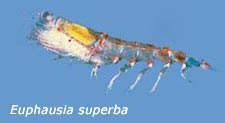|
|
|
|
Krill, A Very Peculiar Shrimp… One of the main targets of current oceanographical research is the krill. This is a tiny crustacean, resembling a shrimp, which is about 6 to 7 centimetres long, with five pairs of legs and two large black eyes: when alive, its nearly transparent body is coloured with little red dots, and, through its scales, its digestive system is visible, green in colour from the phytoplanktonic organisms that constitute its principal food. Contrary to what the laws of adaptation to a natural habitat could lead one to believe because it proliferates in the Antarctic waters, the krill would appear to be poorly adapted to the environment in which it lives; heavier than the water, it in effect has to make constant use of its "paddles" to stay afloat and expends 40% of its energy simply staying immobile in the water. The Antarctic krill - Euphausia superba - belongs to the Euphausiacea, planktonic crustaceans of which there are 85 known species spread throughout the world. Although it is unknown, the krill is the most abundant animal on Planet Earth. The total population of Antarctic krill has been estimated in effect at 600,000 billion items with an average density of 19 million shrimps per square kilometre. The total weight of krill is estimated to exceed the weight of the human population, at around 650 million tons (1). One could imagine that such a quantity of disposable resources has for a long time alerted those who are in permanent quest for new sources of protein for human consumption. It was the Russians and the Japanese who, in the seventies, were the first to show an interest in krill. Several years later, the FAO (Food and Agricultural Organisation) looked into the problem and estimated that, given the proliferation of the crustacean, it would doubtless be possible to fish about 40 tons of it per hour without risking any harm to the marine ecosystem. Several problems have however reared themselves in the path of those who wanted to commercialise the krill: ·
Result: these problems have led to commercialisation that was more expensive than envisaged, miraculous fishing has not taken place, and the operating turnover has not achieved the expected heights. This has however not prevented the krill from being proposed in Russia and Southeast Asia as a delicacy (or as feed for cattle and fish-farming), and the chitin contained in its cuticle (chitin is an organic substance with a structure similar to that of cellulose) from being used as medicine and certain industrial applications. Fearing that industrial fishing might imbalance the Antarctic marine environment, the BIOMASS programme undertook scientific studies on the krill at the beginning of the eighties in order to investigate its role in the Antarctic marine ecosystem. Until this period, in fact, the only things known about this curious crustacean were the fruit of laboratory observations on dead krill. However, it soon proved indispensable to know more about it, and in particular its behaviour in its natural habitat, if one wanted optimum management of the resources and its inclusion among industrial catches. Since then, the science has progressed but numerous questions still remain unanswered. Little is yet known, for example, about the fate of this tiny crustacean during the long months of the austral winter; one supposes that after the fashion of numerous Antarctic species that have developed totally specific survival stratagems, the krill could take advantage of the southern winter by fastening itself to the surface ice, thereby giving its organism something of a rest.
Questions concerning the distribution of the krill must also be added to the ones above; it is still not known today whether it keeps itself to certain zones of dense concentration (observed by oceanographic research campaigns) or whether it tends to follow the marine currents. Until a short while ago, its life expectancy was estimated to be approximately three years: but laboratory experiments have shown that the krill could live, in captivity, for up to 11 years. Normally, the age of a crustacean is determined by its size, which increase with each moult; but in the case of the krill, it has been observed that its size can vary according to the quantity and frequency of its feed, so one cannot rely on a simple deduction of age according to dimension in order to tell the age of a specimen. At the stage of our current knowledge, this amalgam of uncertainty makes it impossible to estimate with any degree of accuracy the krill production, which constitutes a considerable impediment for any international management of its exploitation. Be that as it may, if in Antarctic spheres the krill is talked about all the time these days, it is because this tiny crustacean is nothing other than the central and essential link in the food chains of the Southern Ocean; it provides, in effect, the major sustenance of five species of whale, three species of seal and the majority of penguins, myriad birds, and a good number of fish and squid. Which is to explain the principal role played by this fascinating shrimp in the balance of the Antarctic marine ecosystem.
(1) Antarctica, the last frontier, Richard Laws, Boxtree Limited, 1989, p 91.
|

